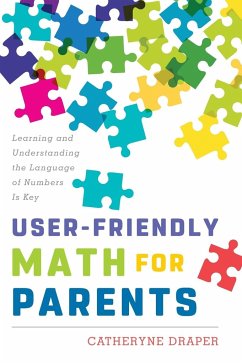Catheryne Draper
User-Friendly Math for Parents
Learning and Understanding the Language of Numbers Is Key
Catheryne Draper
User-Friendly Math for Parents
Learning and Understanding the Language of Numbers Is Key
- Gebundenes Buch
- Merkliste
- Auf die Merkliste
- Bewerten Bewerten
- Teilen
- Produkt teilen
- Produkterinnerung
- Produkterinnerung
This book focuses more on the "why" reasons behind math number relationships, explained in plain English and with images that show number relationships.
Andere Kunden interessierten sich auch für
![User-Friendly Math for Parents User-Friendly Math for Parents]() Catheryne DraperUser-Friendly Math for Parents49,99 €
Catheryne DraperUser-Friendly Math for Parents49,99 €![Nalanda School implementing child friendly education in Bangladesh Nalanda School implementing child friendly education in Bangladesh]() Sufia FerdousiNalanda School implementing child friendly education in Bangladesh26,99 €
Sufia FerdousiNalanda School implementing child friendly education in Bangladesh26,99 €![Improving Research Through User Engagement Improving Research Through User Engagement]() Mark RickinsonImproving Research Through User Engagement180,99 €
Mark RickinsonImproving Research Through User Engagement180,99 €![AN EDUCATIONAL AND FAMILY FRIENDLY PROSPECTUS AN EDUCATIONAL AND FAMILY FRIENDLY PROSPECTUS]() Harry Gael MichaelsAN EDUCATIONAL AND FAMILY FRIENDLY PROSPECTUS16,99 €
Harry Gael MichaelsAN EDUCATIONAL AND FAMILY FRIENDLY PROSPECTUS16,99 €![Learner Friendly Classroom Management - The Essential Learner Friendly Classroom Management - The Essential]() Bindusha K.Learner Friendly Classroom Management - The Essential26,99 €
Bindusha K.Learner Friendly Classroom Management - The Essential26,99 €![A user guide on cryptographic programs A user guide on cryptographic programs]() S.V DivyaA user guide on cryptographic programs29,99 €
S.V DivyaA user guide on cryptographic programs29,99 €![Eco-Friendly Production of Baby Corn and Moongbean Eco-Friendly Production of Baby Corn and Moongbean]() Ekta KumariEco-Friendly Production of Baby Corn and Moongbean47,99 €
Ekta KumariEco-Friendly Production of Baby Corn and Moongbean47,99 €-
-
-
This book focuses more on the "why" reasons behind math number relationships, explained in plain English and with images that show number relationships.
Hinweis: Dieser Artikel kann nur an eine deutsche Lieferadresse ausgeliefert werden.
Hinweis: Dieser Artikel kann nur an eine deutsche Lieferadresse ausgeliefert werden.
Produktdetails
- Produktdetails
- Verlag: Rowman & Littlefield Publishers
- Seitenzahl: 160
- Erscheinungstermin: 8. Juni 2017
- Englisch
- Abmessung: 260mm x 183mm x 13mm
- Gewicht: 509g
- ISBN-13: 9781475834192
- ISBN-10: 1475834195
- Artikelnr.: 47588862
- Herstellerkennzeichnung
- Libri GmbH
- Europaallee 1
- 36244 Bad Hersfeld
- gpsr@libri.de
- Verlag: Rowman & Littlefield Publishers
- Seitenzahl: 160
- Erscheinungstermin: 8. Juni 2017
- Englisch
- Abmessung: 260mm x 183mm x 13mm
- Gewicht: 509g
- ISBN-13: 9781475834192
- ISBN-10: 1475834195
- Artikelnr.: 47588862
- Herstellerkennzeichnung
- Libri GmbH
- Europaallee 1
- 36244 Bad Hersfeld
- gpsr@libri.de
Catheryne Draper has been learning from her students for over half a century of teaching, supervising the math program in a school district, advising math education at the state level, coaching math in schools, and presenting math workshops for teachers. She is the author of The Algebra Game, a hands-on multi-deck algebra program in four topics covering Linear Graphs, Quadratic Equations, Conic Sections, and Trig Functions that allows students to work together in cooperative groups, or individually, to identify the algebra relationships and patterns in the each topic and in the organization across the topics. In addition to contributing many published articles, Draper is also the author of Winning the Math Homework Challenge: Insights for Parents To See Math Differently.
Preface Foreword Introduction Part I: Definition 1. Getting a Grip on
Number Sense Number Freedom Flexibility Through Composition and
Decomposition of Numbers How Counting Can Make or Break Number Sense Ducks,
Gauss, and George Keep in Mind 2. The Map of Number Symbol Territory The
Shapes of Reading Numbers Is Subitizing About Another Shape to Recognize?
Alphabet of Letters and Alphabet of Digits Writing Numbers and Reading
Symbolism Keep in Mind 3. An Evolution of Number and Naming Rights Counting
(Natural), and Whole Numbers Integers and Other Positive and Negative
Absurd Numbers Rational Numbers Include Fractions and Other Number
Comparisons Politics of Rational and Unutterable Irrational Numbers
Infinity, Googol, and Other Very Large Ideas Keep in Mind Part II:
Organization 4. Classify First Three Is Not Red Classification as an
Essential Skill Different Classifications Lead to Increased Flexibility
Keep in Mind 5. Whence Came Place Value? Digits Continue to be the Alphabet
for Numbers Some Cautionary Tales About Learning Place Value Classifying by
Size for Place Value Transitioning to Place Value Record-Keeping Charles'
Overlays Decimals Continue the Same Organization, Just Smaller Keep in Mind
6. The Number Line Brings Numbers to Order First, Last, and In Between -
The Nature of Order Repetition of Pattern in Sequential Order A Place for
Everything Keep in Mind Part III: Relationships and Patterns 7. Pattern
Ancestors Repeating Patterns Growing Patterns Ancestors of Figurate Numbers
and Other Growing Patterns Patterns Inside EquivalencesExpressing Ancestral
Rules as Algebra Relationships Keep in Mind 8. Balance of Relationships and
Patterns Flexibility Within Balance Balance in Fraction Equivalences
Decimal Numbers Are Connections to the Other Side Finding Patterns With
ViewfindersKeep in Mind 9. Number Personalities Even and Odd Numbers Prime
and Composite Numbers Positive and Negative Integers Numbers Can Have
Multiple Number Personalities Keep in Mind Part IV: Connections 10. Place
Value LegaciesExponents and Logarithms Location Matters Reciprocals: A
Location and an Inverse Who Moved My Decimal? Keep in Mind 11. Ratio: The
Comparison Effect Predicaments Around Understanding Fraction as a Ratio
Notation Ratio Pairs Can Make Proportions Percentage: A Location and a Rate
Keep in Mind 12. More Order From the Number Line Number Lines Are
Everywhere Coordinate Axes More Coordinate Connections Keep in Mind
Conclusion: What Parents Can Do Ask Questions Advocate for Number Sense
Find Your Math Voice Keep in Mind Glossary References About the Author
Number Sense Number Freedom Flexibility Through Composition and
Decomposition of Numbers How Counting Can Make or Break Number Sense Ducks,
Gauss, and George Keep in Mind 2. The Map of Number Symbol Territory The
Shapes of Reading Numbers Is Subitizing About Another Shape to Recognize?
Alphabet of Letters and Alphabet of Digits Writing Numbers and Reading
Symbolism Keep in Mind 3. An Evolution of Number and Naming Rights Counting
(Natural), and Whole Numbers Integers and Other Positive and Negative
Absurd Numbers Rational Numbers Include Fractions and Other Number
Comparisons Politics of Rational and Unutterable Irrational Numbers
Infinity, Googol, and Other Very Large Ideas Keep in Mind Part II:
Organization 4. Classify First Three Is Not Red Classification as an
Essential Skill Different Classifications Lead to Increased Flexibility
Keep in Mind 5. Whence Came Place Value? Digits Continue to be the Alphabet
for Numbers Some Cautionary Tales About Learning Place Value Classifying by
Size for Place Value Transitioning to Place Value Record-Keeping Charles'
Overlays Decimals Continue the Same Organization, Just Smaller Keep in Mind
6. The Number Line Brings Numbers to Order First, Last, and In Between -
The Nature of Order Repetition of Pattern in Sequential Order A Place for
Everything Keep in Mind Part III: Relationships and Patterns 7. Pattern
Ancestors Repeating Patterns Growing Patterns Ancestors of Figurate Numbers
and Other Growing Patterns Patterns Inside EquivalencesExpressing Ancestral
Rules as Algebra Relationships Keep in Mind 8. Balance of Relationships and
Patterns Flexibility Within Balance Balance in Fraction Equivalences
Decimal Numbers Are Connections to the Other Side Finding Patterns With
ViewfindersKeep in Mind 9. Number Personalities Even and Odd Numbers Prime
and Composite Numbers Positive and Negative Integers Numbers Can Have
Multiple Number Personalities Keep in Mind Part IV: Connections 10. Place
Value LegaciesExponents and Logarithms Location Matters Reciprocals: A
Location and an Inverse Who Moved My Decimal? Keep in Mind 11. Ratio: The
Comparison Effect Predicaments Around Understanding Fraction as a Ratio
Notation Ratio Pairs Can Make Proportions Percentage: A Location and a Rate
Keep in Mind 12. More Order From the Number Line Number Lines Are
Everywhere Coordinate Axes More Coordinate Connections Keep in Mind
Conclusion: What Parents Can Do Ask Questions Advocate for Number Sense
Find Your Math Voice Keep in Mind Glossary References About the Author
Preface Foreword Introduction Part I: Definition 1. Getting a Grip on
Number Sense Number Freedom Flexibility Through Composition and
Decomposition of Numbers How Counting Can Make or Break Number Sense Ducks,
Gauss, and George Keep in Mind 2. The Map of Number Symbol Territory The
Shapes of Reading Numbers Is Subitizing About Another Shape to Recognize?
Alphabet of Letters and Alphabet of Digits Writing Numbers and Reading
Symbolism Keep in Mind 3. An Evolution of Number and Naming Rights Counting
(Natural), and Whole Numbers Integers and Other Positive and Negative
Absurd Numbers Rational Numbers Include Fractions and Other Number
Comparisons Politics of Rational and Unutterable Irrational Numbers
Infinity, Googol, and Other Very Large Ideas Keep in Mind Part II:
Organization 4. Classify First Three Is Not Red Classification as an
Essential Skill Different Classifications Lead to Increased Flexibility
Keep in Mind 5. Whence Came Place Value? Digits Continue to be the Alphabet
for Numbers Some Cautionary Tales About Learning Place Value Classifying by
Size for Place Value Transitioning to Place Value Record-Keeping Charles'
Overlays Decimals Continue the Same Organization, Just Smaller Keep in Mind
6. The Number Line Brings Numbers to Order First, Last, and In Between -
The Nature of Order Repetition of Pattern in Sequential Order A Place for
Everything Keep in Mind Part III: Relationships and Patterns 7. Pattern
Ancestors Repeating Patterns Growing Patterns Ancestors of Figurate Numbers
and Other Growing Patterns Patterns Inside EquivalencesExpressing Ancestral
Rules as Algebra Relationships Keep in Mind 8. Balance of Relationships and
Patterns Flexibility Within Balance Balance in Fraction Equivalences
Decimal Numbers Are Connections to the Other Side Finding Patterns With
ViewfindersKeep in Mind 9. Number Personalities Even and Odd Numbers Prime
and Composite Numbers Positive and Negative Integers Numbers Can Have
Multiple Number Personalities Keep in Mind Part IV: Connections 10. Place
Value LegaciesExponents and Logarithms Location Matters Reciprocals: A
Location and an Inverse Who Moved My Decimal? Keep in Mind 11. Ratio: The
Comparison Effect Predicaments Around Understanding Fraction as a Ratio
Notation Ratio Pairs Can Make Proportions Percentage: A Location and a Rate
Keep in Mind 12. More Order From the Number Line Number Lines Are
Everywhere Coordinate Axes More Coordinate Connections Keep in Mind
Conclusion: What Parents Can Do Ask Questions Advocate for Number Sense
Find Your Math Voice Keep in Mind Glossary References About the Author
Number Sense Number Freedom Flexibility Through Composition and
Decomposition of Numbers How Counting Can Make or Break Number Sense Ducks,
Gauss, and George Keep in Mind 2. The Map of Number Symbol Territory The
Shapes of Reading Numbers Is Subitizing About Another Shape to Recognize?
Alphabet of Letters and Alphabet of Digits Writing Numbers and Reading
Symbolism Keep in Mind 3. An Evolution of Number and Naming Rights Counting
(Natural), and Whole Numbers Integers and Other Positive and Negative
Absurd Numbers Rational Numbers Include Fractions and Other Number
Comparisons Politics of Rational and Unutterable Irrational Numbers
Infinity, Googol, and Other Very Large Ideas Keep in Mind Part II:
Organization 4. Classify First Three Is Not Red Classification as an
Essential Skill Different Classifications Lead to Increased Flexibility
Keep in Mind 5. Whence Came Place Value? Digits Continue to be the Alphabet
for Numbers Some Cautionary Tales About Learning Place Value Classifying by
Size for Place Value Transitioning to Place Value Record-Keeping Charles'
Overlays Decimals Continue the Same Organization, Just Smaller Keep in Mind
6. The Number Line Brings Numbers to Order First, Last, and In Between -
The Nature of Order Repetition of Pattern in Sequential Order A Place for
Everything Keep in Mind Part III: Relationships and Patterns 7. Pattern
Ancestors Repeating Patterns Growing Patterns Ancestors of Figurate Numbers
and Other Growing Patterns Patterns Inside EquivalencesExpressing Ancestral
Rules as Algebra Relationships Keep in Mind 8. Balance of Relationships and
Patterns Flexibility Within Balance Balance in Fraction Equivalences
Decimal Numbers Are Connections to the Other Side Finding Patterns With
ViewfindersKeep in Mind 9. Number Personalities Even and Odd Numbers Prime
and Composite Numbers Positive and Negative Integers Numbers Can Have
Multiple Number Personalities Keep in Mind Part IV: Connections 10. Place
Value LegaciesExponents and Logarithms Location Matters Reciprocals: A
Location and an Inverse Who Moved My Decimal? Keep in Mind 11. Ratio: The
Comparison Effect Predicaments Around Understanding Fraction as a Ratio
Notation Ratio Pairs Can Make Proportions Percentage: A Location and a Rate
Keep in Mind 12. More Order From the Number Line Number Lines Are
Everywhere Coordinate Axes More Coordinate Connections Keep in Mind
Conclusion: What Parents Can Do Ask Questions Advocate for Number Sense
Find Your Math Voice Keep in Mind Glossary References About the Author








